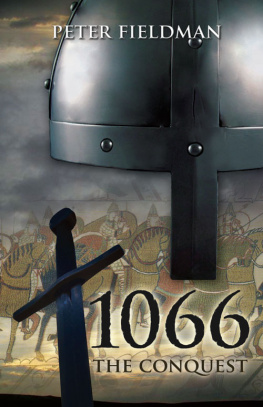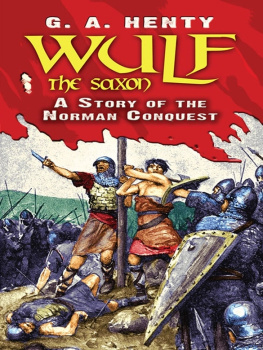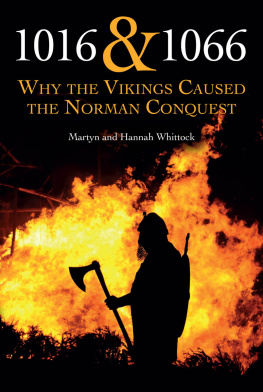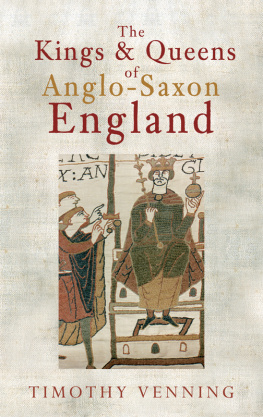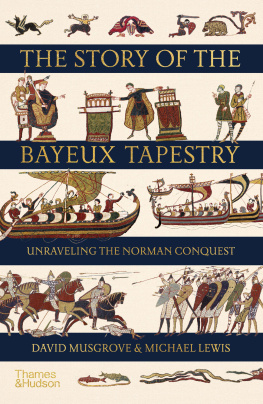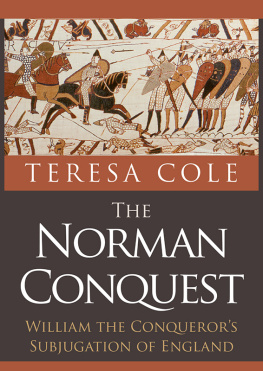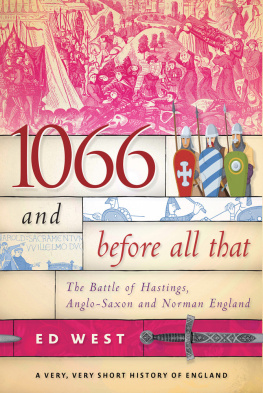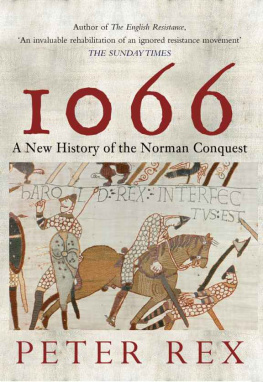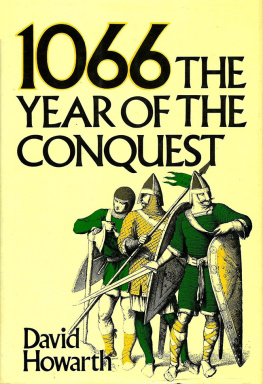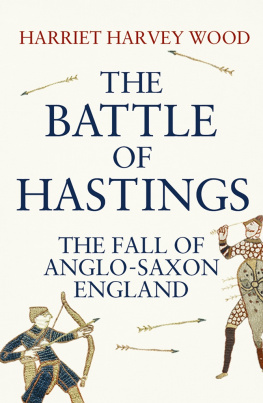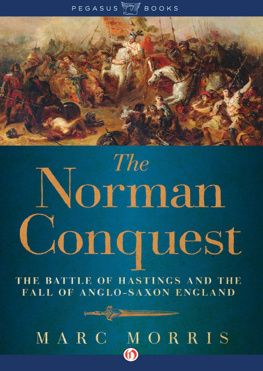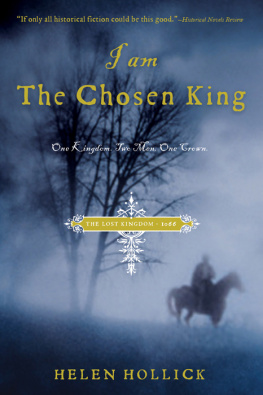
Sources
The Anglo Saxon Chronicles
The Viking Ship Museum Oslo
The Tapestry Museum in Bayeux
Scenes from the XI century Bayeux Tapestry reproduced with special authorisation and courtesy of the Town of Bayeux
XIX century prints from Histoire de France by Henri Martin
Acknowledgements
History is the path to the future.
I extend my gratitude for helping me to bring these events to life:
To my wife Lucia for having put up with me for so long working on this project
To our friend Anke for the use of her Mediterranean apartment where I found inspiration
To Paul Fieldman for his collaboration and computer design skills
To the cooperation of the City of Bayeux
To the Cafe Hugo in Paris where I spent so much time revising the manuscript

All men dream: but not equally.
Those who dream by night in the
dusty recesses of their minds wake in
the day to find that it is vanity.
But the dreamers of the day are dangerous
men for they act their dreams with
open eyes to make it possible.
T. E. Lawrence


Preface
On the 6th January 1066 Harold Godwinson, Earl of Wessex, was crowned King of England. His reign was short lived. Ten months later he was lying dead in an English field. The man who succeeded him was a Norman called William or, to give him his correct title, Guillaume, Duke of Normandy. All these facts can be found in the Saxon Chronicles.
But the real story of the Norman invasion and how William came to claim the throne of England has been recorded for posterity in a unique seventy metre long, coloured embroidery known throughout the world as the Bayeux Tapestry. This extraordinary visual interpretation of the events leading up to the Battle of Hastings, dating from the eleventh century and incorporating action scenes with elements of medieval life, has survived for a thousand years despite wars, political upheaval and revolutions. Initially credited to Williams wife, Matilda of Flanders, it is believed to be the work of Kentish craftsmen undertaken sometime between 1070 and 1077.
Although the rise to power of William in Normandy and Harolds influence in England spanned in excess of two decades, the story depicted in the Tapestry is limited to the two year period between 1064 and 1066. Despite the mystery and controversy surrounding the Tapestrys creator, it was most likely commissioned by Odo (or Odon) de Conteville, Bishop of Bayeux, and the Conquerors half brother, after his appointment as Earl of Kent, to be exhibited in Bayeux Cathedral.
If the dates are correct, it was a remarkable achievement that a decade after the invasion Bishop Odo managed to convey, either from memory or from a diary that he had compiled, a precise description set out in the form of an extraordinary coloured comic strip, divided into fifty eight separate scenes, of the circumstances leading up to what was arguably one of the greatest military expeditions of its time.
This is an account of the events depicted in the Bayeux Tapestry and those that led up to the battle. It is the story of two men, one Saxon, the other Norman, both claiming the throne of England, whose destinies were to lead to a final confrontation on an English hillside that changed the course of English history. It also portrays the love between two people in a marriage that lasted for more than thirty years and was deemed to have remained a faithful union, which, during one of the most tempestuous periods of our time, produced ten children.
The battle of Hastings and the death of Harold Godwinson, the King of England mortally wounded, so legend has it, by a stray Norman arrow which pierced his eye, are part of English folklore. But what do we know about William, the man destined to be King? He was the illegitimate son of a Norman Duke, propelled into the role of Duke of the Duchy when he was only eight. From this point on, history tells us he grew up to be a faithful husband, a devoted father, an able administrator, a pious Christian and a ruthless warlord. Moreover, at thirty-nine years old, with not a drop of English blood in his veins, he became King and undisputed ruler of England as well as of his native Normandy.
While Williams achievements and brutality as King of England between 1066 and 1087 are well documented, there has been relatively little interest shown in the origins of this charismatic figure from Normandy, who after two decades of intrigue, rivalry and conflict, defeated rebellious Barons and warmongering neighbours to establish a highly organised and efficient feudal system with the support of the church. Having managed to overcome the inner conflict arising from his illegitimate origin as well as political rivalry and military resistance from his opponents, he brought peace to his Duchy and then persuaded soldiers, peasants, mercenaries and adventurers from across Europe to join his armada and undertake a risky and perilous expedition to invade England and claim the crown. For this reason, the year 1066 remains engraved on the mind of every schoolchild as the most important date in English history.
Introduction
By the beginning of the eleventh century, the Normans, men from the north, who were descendants of the Vikings, had established one of the most powerful and warlike states in Christendom. Their influence extended to Spain and as far as Sicily. It was a period that saw great changes taking place across the world. Even as armed conflicts led to the rise and fall of regimes and monarchies, art and religion were becoming established aspects of society. In Spain El Cid would push back the Moors leading ultimately to its reunification; the Byzantine Empire extended from Constantinople throughout the Middle East; it was the Heian period in Japan, ruled from Kyoto, the capital city where Buddism was reaching the masses; a new class of warrior, whose legacy remains to this day, became established - the Samourai. Neighbouring China was controlled by the Song Dynasty, the Maya civilisation was predominant in Central America and in Rome the Pope was extending his power and influence on society as the Christian church began to spread into the Feudal societies, expanding across Europe and even taking an active role in military conflicts.
As descendants of the Vikings the Normans had inherited a fighting spirit and brought with them a new style of offensive warfare unknown in Saxon and Viking occupied England. Their strategy relied on the mobility of mounted knights armed with lances and swords, able to sweep into battle at speed and adapt to changing tactics of enemy forces quickly. The cavalry was supported by bowmen, lined up in close formation, concentrating their fire power by unleashing a barrage of arrows into the sky to rain down on opponents like modern mortar or artillery fire. It was also the beginning of the age of stone built castles; impregnable strongholds built to secure the possession and occupation of conquered territory that would play an essential role in the expansion of Norman influence.
England, at this time, found itself torn by rivalry between Saxons, Vikings and Celts each controlling different regions of the country and claiming the throne for one of their own. Such was the danger to King Aethelred, that the Queen, Emma, sent her two children, Alfred and Edward, to seek refuge with her brother, Duke Robert I, in Normandy. Following Aethelreds death in 1016, while her children were growing up in Normandy, Emma re- married, this time to Cnut, the new King from Denmark and she bore him a son, Hardicanute.
Next page
